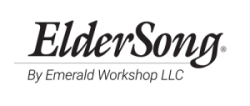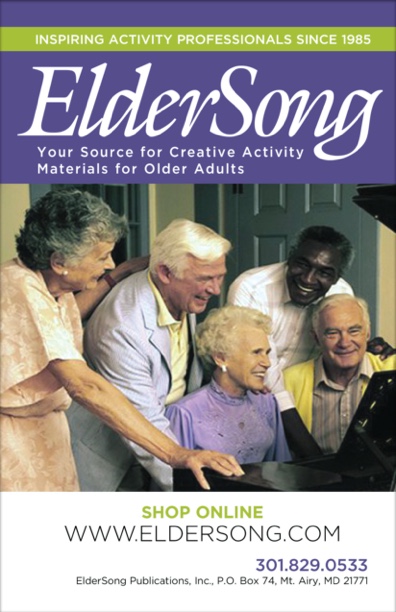On the first Tuesday after the first Monday in November, every four years, Americans head to the polls to elect the president of the United States. As Election Day nears, voters ponder whom to choose for the nation’s highest political office. Older adults have participated in many presidential elections, witnessing both landslides and defeats. This civic-minded generation can easily attest to the importance of exercising the right to vote for a new commander-in-chief. Here are some activities designed to evoke memories of going to the polls on a presidential election day. You can adapt them to the particular needs of your group.
- Brainstorm a list of election terms with your group – e.g., polls, ballot, dark horse – to elicit memories of election days.
- Show a film on the American presidency, which includes presidential portraits (e.g., PBS documentary series The American President). Serve a patriotic dessert: a flag-shaped cake with white frosting, blueberries, and strawberries. Ask: Which president do you most admire?
- Watch the 1939 film Young Mr. Lincoln, starring Henry Fonda. A more recent film to view is Dave, about a presidential impersonator who ends up running the country.
- Sing some old political campaign songs, such as “I’m Just Wild About Harry” or “I Like Ike.”
- Display pictures of the Republican elephant and the Democratic donkey. Ask the group what issues are important to them this year.
- Reminisce about memorable elections, such as the 1960 Kennedy/Nixon contest. Show historic photographs of their first televised debates. Ask: Did you watch the debates on TV or listen on the radio? Who do you think won the debates?
- Learn about the tradition of Election Day cake. (Check the Internet for recipes.)
- Explore the meaning of some clichés associated with politics/elections. Examples: Throw your hat in the ring, jump on the bandwagon, politics makes strange bedfellows, running neck and neck.
- Talk about the qualifications of the current presidential contenders and the importance of choosing leaders wisely. Ask: When casting a vote, which do you consider the most important – political party, position on key issues, or personal qualities of a candidate?
- Invite a collector of campaign memorabilia to share some of his/her election keepsakes – campaign buttons with portrait of candidate and slogan, posters, bumper stickers, placards, postcards, leaflets. Compare the messages from these items to those of the current presidential election.
- Encourage participants to design a paper or straw campaign hat, pennant, placard, or t-shirt for their favorite nominee. Hold a mock election and encourage each participant to cast a ballot for president/vice-president.
- Plan an Election Day party. Hang patriotic decorations and enjoy some favorite dips and spreads with crackers, breads, and vegetables. Challenge your group to a presidential trivia quiz.
- Read some poems by Walt Whitman, known as the Poet of Democracy (e.g., “Election Day, November 1884” from Leaves of Grass, 1892). Encourage participants to share their sentiments on living in America and enjoying the privilege of voting in a democracy.
- Play some rousing patriotic music from “The President’s Own,” the U.S. Marine Band. Listen to the official song of the president of the United States, “Hail to the Chief.”
- Reminisce about American politics in the post World War II-era. Ask: What do you recall about the 1952 and 1956 presidential elections with Dwight Eisenhower? Can you explain why Eisenhower’s campaign used “I Like Ike” and “Peace and Prosperity” as his slogans?
- Mention the phrase “whistle-stop train tour” to your group, and you’re likely to hear about President Harry S. Truman. Ask your participants what they remember about Truman’s 1948 Whistle-Stop Campaign Train Trip across America. Listen to audio recordings of Truman’s 1948 presidential campaign, a whistlestop tour in which he gave speeches from the rear platform of a train. Other presidents have used train travel during an election year, including George H.W. Bush, who made whistle-stop tours aboard his 1992 campaign train.
- Voting is a civic activity shared by Americans over the years. Say the following words to your group: ballot, voting booth, polling place, poll workers. Ask participants how old they were when they cast their first vote for president. Who were the candidates? What type of voting machine/booth was used? Where was the polling place located?
PRESIDENTIAL ELECTION TRIVIA
Challenge your group to recall some of the men (and women) who have been a part of presidential elections history.
- He was the youngest American to be elected president, at age 43. John F. Kennedy
- He is the only American president elected to office four terms, beginning in 1932. Franklin D. Roosevelt
- This World War II hero was first elected president in 1952. Dwight D. Eisenhower
- These two candidates participated in the first televised presidential debate in 1960. John Kennedy and Richard Nixon
- One of his campaign slogans in the 1976 presidential contest was “Not Just Peanuts.” Jimmy Carter
- This incumbent Republican president lost to Jimmy Carter in the 1976 election, after having been president for only two years. Gerald Ford
- He won a landslide victory over conservative Barry Goldwater in the 1964 presidential election. Lyndon Johnson
- At age 69, he was the oldest person ever elected U.S. president. Ronald Reagan
- This incumbent president was considered the underdog in his bid for re-election against Thomas Dewey in 1948. Harry Truman
- In the 1984 election, Geraldine Ferraro was the first woman to do what? Run for vice president on a major party ticket (as a Democrat with Walter Mondale)
“ELECTION DAY” written by Sue Hansen. © 2008 ElderSong Publications, Inc. All rights reserved.
Reprint Policy: To reprint or republish all or portions of this entry, you must acquire written permission and agree to link back to the original source. Please contact us at [email protected] to obtain permission.


